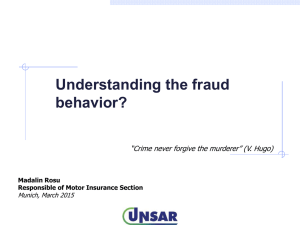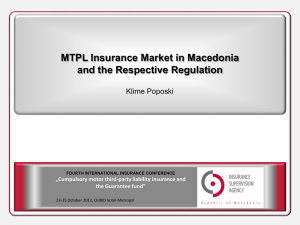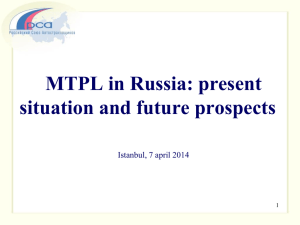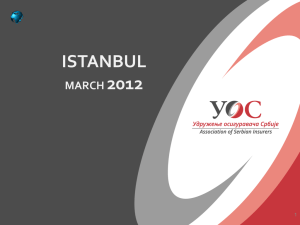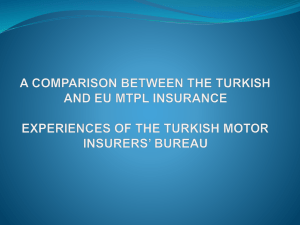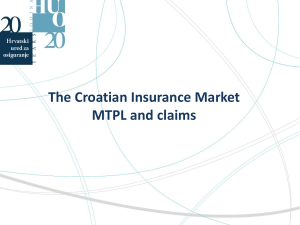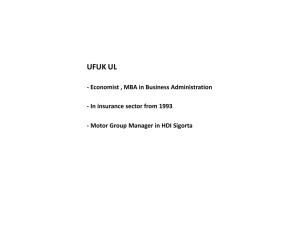Diapozitiv 1 - The International Insurance Forum
advertisement
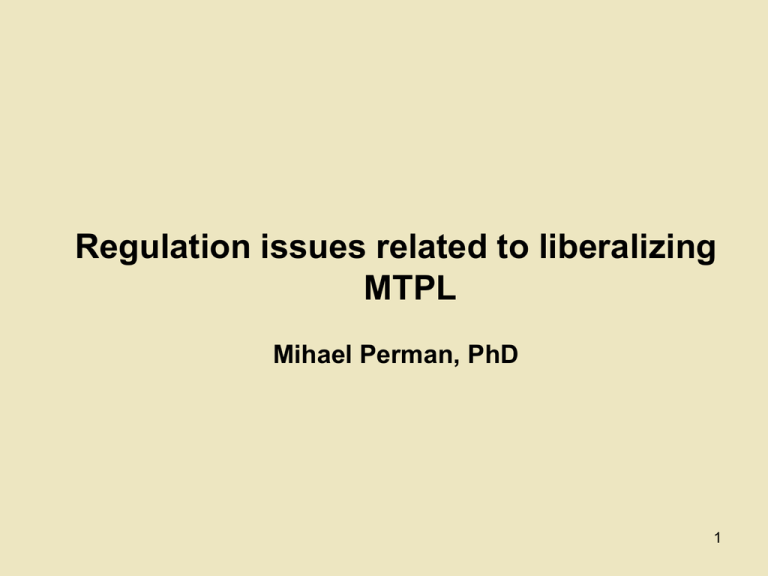
Regulation issues related to liberalizing MTPL Mihael Perman, PhD 1 Overview • Brief history in Slovenia • Some statistics. • Recommendations by Government Actuary’s Department (UK). • Experience after deregulation. • Experience in other countries. • Other hurdles on the way to profitability. • The role of regulators. • Conclusions. 2 Brief history • Prices of MTPL insurance in Slovenia were regulated until August 1999. • The Government determined maximum possible price increases periodically. • MTPL prices were by and large the same across companies. • From 1995 to 1999 cumulative losses were more than a year’s total MTPL premium. 3 Brief history continued • Losses were compensated from other lines of business (mainly fire and most notably health in one composite company). • The Supervisory authority insisted on correct levels od technical provisions and hired outside experts. Companies were underreserved. • At political level economic arguments did not have much effect. 4 Overall statistics 5 Example 1 – a pitfall 6 Comment • Usually claims are settled over a period of years. • New premium can be used to pay claims from older policies. • If premium is not sufficient the problem will not go away but fester under the surface. • If more claims are paid than premium collected eventually there will be a big problem. 7 Real loss development 8 Importance of MTPL to the industry 9 Comparison of reserves by GAD 10 Comment • Most companies were underreserved-some of them substantially. • Most companies were “in trouble” with MTPL. • GAD anticipated that price regulation would force companies out of the MTPL business unless a 40-50% price increases were allowed thus reducing competition and availability of cover. 11 Recommendation of GAD • • • • Remove price controls. Reduce cost. Introduce more risk sensitive pricing. Encourage safety precautions like seat belts and reward safe driving. 12 Experience after deregulation • There were no major surprises. • The premium slowly notched upwards but there were no sudden big increases. • The Supervisory authority allowed a gradual buildup of provisions in order not to weaken companies too much. • Over a period of several years the technical provisions reached adequate levels. By the time of EU entry the loss ratios were reasonable. 13 Experience long after deregulation Table 1: MTPL insurance in Slovenia in years 2007-2009 Loss ratio (in %) Comb. Loss ratio (in %) Exp. ratio (in %) Gross premium written (in EUR) Gross claims incurred (in EUR) Number of policies Number of clai ms 2007 54,80 73,97 19,17 329.924.855 182.187.187 1.641.479 70.575 2008 53,92 72,95 19,04 336.264.942 184.291.169 1.697.097 69.379 2009 57,46 77,08 19,61 322.983.306 184.559.160 1.693.240 71.164 Source: Statistical bulletins St-10, St-23, St-27 and St-53. 14 Experience in other countries • JORDAN: Companies went collectively “on strike” and stopped selling MTPL because of regulated pricing creating an unpleasant situation for consumers and regulator. • MACEDONIA: Prices are still regulated at levels that are too low. They were lowered during the electoral campaign due to snap elections. Liberalization announced for years. 15 Experience continued • KOSOVA: Liberalization announced for years but there is fear of underpricing. • MONTENEGRO: Regulated prices with companies struggling to break even. 16 Conclusions about regulated prices • Political interventionism to keep consumers happy and inflation in check is not the right way to go. Someone has to pay anyway. • Stability and healthy competition comes about when the right levels of technical provisions are established and enforced by regulators. • Low premium to undermine competition remains a problem which is difficult to deal with for regulators. 17 Other hurdles • Fraud is believed to cost about 5% of total premium worldwide. What can be done? 18 Possible measures Establish firm control over claim adjusters. Need to do the homework. Fraud should not be simply factored into pricing. Companies need to do their homework. Agree on a common database of fraud cases accessible to all companies. Use software for fraud detection and blacklist. 19 Intermediaries • The fees of intermediaries are killing us. What do we do? 20 Possible measures Develop retail networks under the control of the company. Careful tracking if premium is paid in installments. Careful tracking that intermediaries do pass on the premium to the company. 21 The competition is killing us • Healthy competition is the best way to establish the right levels of premium. 22 Possible measures Do not give in to pressure of the market if you know prices are too low. Establish good risk management and corporate governance. Take a long term view. Introduce more risk based pricing. Bring up the problem in Insurance associations. 23 24 Conclusions • Companies need to do their “homework”. • The regulator does not have the “magic wand” that will do the work the companies need to themselves. • The regulator will usually not intefere in squables between companies. 25 Regulatory issues • There is a role for regulators and regulation in MTPL. • There is a role for competition authorities. 26 What can regulators do Monitor the levels of technical provisions more closely. Strictly enforce solvency. Licence interemediaries and aggressively withdraw licences in cases of infringement. Include assessments of IT systems in onsite inspections. 27 What can regulation do More risk based capital requirements may help. Solvency 2 style “disclosure” can be a powerful tool. If everyone sees poor performance it is a deterrent. ORSA may be onerous but can be a powerful wake-up tool for management. 28 Conclusion There is a way to profitability. It takes good management of companies, good market discipline with its enforcement and right regulation. THANK YOU 29
